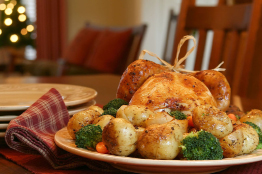Module 1
1. Module 1
1.25. Page 5
Module 1: The International System of Units (SI)
Lesson Summary

© Hannamariah/shutterstock
A knowledge of temperature is important for more than just helping you dress appropriately for the weather. For example, meats must be cooked to high-enough temperatures to avoid illness. For instance, the Canadian Food Inspection Agency recommends that whole poultry, such as turkey, duck, or goose, should be cooked to an internal temperature of 85°C. You can check the internal temperature using a meat thermometer.
In this lesson you explored these questions:
-
How is temperature measured in SI?
-
What is the history of the SI temperature scale?
-
How is the SI temperature scale used today?
Check your level of understanding of the materials covered in this lesson by completing “Lesson 5 Traffic Lights.” If you select an amber or red traffic light in the multimedia piece, you will receive information about additional work you can complete to improve your understanding of the topics. Complete the suggested work before you proceed to the Lesson 5 Assignment. If you experience difficulty, contact your teacher before starting the Lesson 5 Assignment.
In answering these questions, you discovered that the Celsius temperature scale is part of the SI. You explored how the benchmarks on the Celsius scales are related to the melting point of ice and the boiling point of water.
 Assignment
Assignment
Retrieve the Lesson 5 Assignment Booklet you saved in your course folder at the start of this lesson. Complete the Assignment Booklet. Resave your Assignment Booklet in your course folder and submit a copy to your teacher for assessment.
Unit Project
Before you move on to the next part of this unit, you should complete the SI portion of your Unit 1 Project. Please note that when you complete your work later in this unit, you will be asked to indicate measurements using both SI and imperial units. Also identify a calculated area in the work you’ve done so far that you will convert to imperial measure in Module 2. For more information about this step and later steps, refer to the Unit 1 Project.